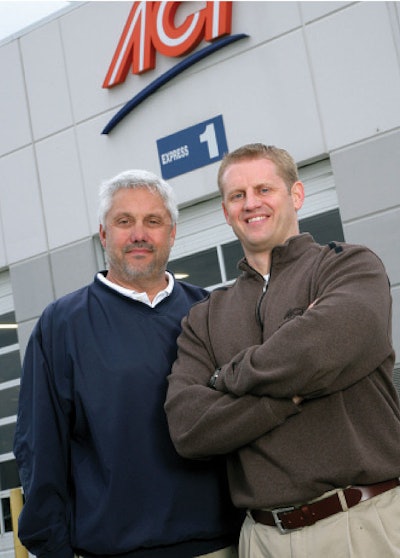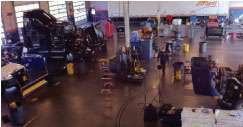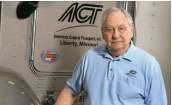American Central Transport
Liberty, Missouri
Missouri carrier develops new recruiting and driver pay programs to tackle driver shortage and improve fuel economy
Escalating fuel prices and an ongoing driver shortage remain top worries for motor carriers nationwide. Even if companies are able to fill empty seats, fuel prices north of $4 per gallon threaten to decrease profitability.
 Tom Kretsinger Jr., president and chief operating officer of American Central Transport (left), and Aaron Thompson, vice president of operations, spearheaded the company’s novel approaches to address fuel prices and the driver shortage.
Tom Kretsinger Jr., president and chief operating officer of American Central Transport (left), and Aaron Thompson, vice president of operations, spearheaded the company’s novel approaches to address fuel prices and the driver shortage.American Central Transport is no different than other carriers in this respect, and these issues remain top concerns for the Liberty, Mo.-based dry van carrier. But developing novel approaches to combat these problems is part of what earned ACT Commercial Carrier Journal’s Innovator of the Year Award.
By analyzing company driver performance, developing an innovative pay structure that incentivizes good driving behavior and creating a recruiting strategy focusing on former drivers returning to the industry, ACT has set itself on a path for success for years to come.
A better way to pay
Like most carriers, ACT was faced with an entitlement mentality among much of its company driver work force. The longer drivers had been with the company, the more they expected to earn. For years, that’s exactly how ACT operated, providing incremental cent-per-mile raises to longer-tenured employees.
But at the height of the recession in 2008, ACT implemented driver scorecards to better monitor individual driver performance. The effort yielded some surprising results: Some of the company’s highest-paid drivers were some of its worst performers, and some of its lowest-paid drivers actually were the most profitable.
ACT staff immediately began coaching poor-performing drivers to improve their scores, but they lacked a way to recognize and incentivize the best drivers to continue performing at a high level.
In 2010, company management devised a new performance-based pay program to tie driver pay to driver scorecard performance. The program was rolled out in January 2011; based on scores from the previous six months, drivers would be paid between 36 and 45 cents per mile for the next six-month period. Quarterly midterm reviews would provide drivers a chance to see areas where they needed to improve in order to maintain or elevate their pay.
 ACT installed a state-of-the-art maintenance facility as part of an overall company effort to control costs and improve efficiencies.
ACT installed a state-of-the-art maintenance facility as part of an overall company effort to control costs and improve efficiencies.ACT’s performance-based pay program for its roughly 90 company drivers is measured by five key metrics – all designed to improve driver performance and accountability. Fuel-related expenses comprise 40 percent of the program’s score weighting – 30 percent for fuel economy (average miles per gallon) and 10 percent for route compliance (prescribed routing and fueling solutions). The remaining 60 percent of score weightings are split among three other metrics: safety performance (roadside violations, crashes and incidents), utilization and on-time pickup and delivery.
In its first year, ACT’s performance-based pay program has yielded impressive results. In 2010, more than 75 percent of ACT’s company drivers earned less than 40 cents per mile; as of this January, almost 75 percent of company drivers now earn 40 cents per mile or more, and one in three drivers make the full 45 cents per mile. Overall, the company average has increased nearly 3 cents per mile in that time.
“It’s not where you’re going, but how you get there – that’s what makes you money.”
– Mike Heintz,
maintenance coordinator
“I want to pay all my drivers 45 cents per mile,” says Tom Kretsinger Jr., president and chief operating officer. “The guy that is doing things right is well worth what we pay him.”
The performance-based pay program has had a positive impact on driver retention during a time when most carrier turnover rates have risen sharply. In January 2011 when the program began, annualized turnover was 96.8 percent. One year later, it dropped to 37.6 percent.
All about fuel
The performance-based pay program has led to a culture shift for ACT’s company drivers. “I’ve talked to more company drivers than independent contractors in the last six months,” says Mike Heintz, ACT’s maintenance coordinator, who also counsels drivers on proper driving habits. “A year ago, that almost never happened.”
While ACT has seen improvements across the board in the five metrics it uses to measure driver performance, it nets the biggest return through fuel savings with improved fuel economy and route compliance.
“The single biggest variable you have is the driver.”
– Aaron Thompson,
vice president of operations
“Before this program came out, I knew how to drive to get good fuel economy, but I wasn’t doing it because there really was no reason to,” says John Hanan, company driver. “Now it makes a lot of sense for us to work at it and get good fuel mileage. It has made me more safety-conscious and more conscientious – it’s affected me everywhere. I wouldn’t want to go back to the old way.”
Aaron Thompson, vice president of operations, says that good equipment spec’ing can net an 8/10-mpg improvement, but a good driver can net up to 3 mpg. “The single biggest variable you have is the driver,” he says.
Since implementing the performance-based pay program, ACT has seen an almost 5 percent improvement in overall fuel economy. The fleet average today is about 7.5 mpg, and some of the company’s top-performing drivers have averaged better than 8 mpg on a quarterly basis.
“There’s no reason a driver can’t stay in the mid-7 to mid-8 mpg range on a regular basis without even thinking about it,” says Heintz. “It’s just that no one has ever taken the time to explain to them how to drive the new equipment. Once that’s explained to them, they can get 7.5 mpg all day long. It’s just taking the time to talk to them, and then it’s like a light bulb goes on and they can get it done.”
In his role as driver counselor, Heintz focuses on taking off from a dead stop, letting cruise control do its job and reducing overall speeds to improve fuel economy.
“Six years ago before the first fuel spike, we didn’t worry about fuel economy, and we averaged 3,000 miles per week,” says Heintz, recalling his experience as a driver. “Now that freight is a little slower and fuel prices are high, it’s not a ‘hurry up and get there’ approach, but a ‘take your time and get there smartly.’ It’s not where you’re going, but how you get there – that is what makes you money.”
ACT’s routing software provides the driver with a precise route and recommended fuel stops based on the company’s fuel purchase network. It calculates distance between stops and fuel taxes by state to determine the most advantageous place to refuel. Year-over-year, the company has experienced a 15 percent improvement in fuel and route compliance.
The software generates a report that tells management how often a driver complied with the prescribed parameters. “We work a lot on our net fuel costs with rebates and discounts,” says Kretsinger. “By looking at the diesel price on a street sign, a driver has no idea of the true cost we’re paying for the fuel. At one stop, we might have a 14-cent discount, and at another, it might be less. The routing software lets him know where it’s best for him to stop.”
Kretsinger says fuel economy performance even has spilled over to the owner-operator side of the business with contractors developing a competitive atmosphere. “They’ll take a picture of their mpg reading on the ECM with their smartphone and upload it to Facebook – it’s created some good-natured peer pressure,” he says. “They figured out that it’s smart to drive slow and drive smart. Some guys never drive over 55 mph, and they turn in huge numbers and get great nets on their settlements.”
Smart spec’ing
The final part of ACT’s quest to improve fuel efficiency is close attention to tractor spec’ing, a practice that has been a primary focus when ordering late-model equipment. The company has adopted some simple fuel-saving solutions such as super-single tires and tire pressure monitoring and automatic inflation systems on trailers, but it has achieved its greatest results with unconventional solutions.
In 2010, ACT began experimenting with tractors with 6×2 tag-axle configurations to increase efficiency and lower overall vehicle weight to get better fuel economy and carrying capacity. “We were early adopters,” says Thompson. “The technology is now catching on, and suppliers are really making improvements to the way the systems work.”
The experiment yielded immediate benefits. “In one case, a driver that never averaged above 6.5 mpg was suddenly getting close to 7.5 mpg,” says Kretsinger. “There’s definitely something to it.”
ACT also worked with its OEM supplier on tractor design modifications, including removing the visor that was causing a leak point in the cab and creating a maintenance problem. The company also requested removing the vertical exhaust stack and replacing it with a horizontal system that would allow it to move the trailer closer to the cab to improve aerodynamics.
“To keep the weight legal, we were able to get 38 inches from the back of the sleeper to the front of the trailer,” says Thompson. “Before, that gap was 42 inches or more.”
By examining and reworking nearly every aspect of its organization, ACT has proven it isn’t afraid to make bold moves necessary to control costs, improve the bottom line and increase driver efficiency. With the culture that the Kretsinger family has fostered for more than 30 years, that level of innovation likely will continue to propel the company forward for years to come.
Bringing ’em back
Another key initiative introduced last year by American Central Transport was its ACTivate Careers Program, a three-phase finishing school designed to address the need for hiring and training qualified drivers. The program specifically targets former drivers returning to the industry that have at least 18 months of over-the-road experience in the last five years and hold a Class A CDL, as well as military veterans with truck driving experience in the last 18 months. All candidates also must meet ACT’s stringent driver evaluation standards to enter the program.
 ACT developed an online training tool as part of a continuing education program for its drivers.
ACT developed an online training tool as part of a continuing education program for its drivers.Drivers in the ACTivate program spend five days in a classroom orientation setting to learn about new truck technology, electronic onboard recorders and new safety compliance practices before hitting the road with a trainer in one of six specialty “trainer” trucks spec’d with studio sleepers and double bunks. After one or two weeks in the over-the-road training sessions, drivers are seated in a company truck and begin a 60-day probationary period.
“You have to have some refresher training – if you don’t use your driving skills every day, you lose them,” says John Hanan, ACT company driver and instructor in the ACTivate program. “If you’ve been out of the industry for a while, a lot has changed.”
After completing the ACTivate program and remaining with ACT for three months, the driver has the option of staying on as a company driver or converting into a lease-purchase program and becoming an owner-operator. Drivers entering the lease-purchase program are set up with truck leases through ACT’s Excel Leasing & Sales and are enrolled in the Excel Business Institute, which teaches the basics of becoming a successful owner-operator, including trip planning, budgeting and tax planning. Last year, 29 drivers completed their leases with ACT through the Excel platform.
Roots run deep
Led by Tom Kretsinger Sr., chairman and chief executive officer, and his three sons – Tom Jr., president and chief operating officer, Bill, chief marketing officer, and Bob, chief information officer – American Central Transport truly is a family affair. Under their leadership, the Liberty, Mo.-based dry van carrier has grown from modest beginnings to become one of the most reputable and well-respected businesses in the industry.
While ACT has grown considerably in the last several years – the company now operates 315 power units – its roots in the trucking industry go back more than 85 years. Tom Sr.’s father, Carll, opened a law practice specializing in motor carrier transportation law shortly after the Motor Carrier Act of 1935 granted the Interstate Commerce Commission federal authority to regulate the motor carrier industry. Tom Sr. joined his father’s firm in 1957. Tom Jr. became the third-generation motor carrier lawyer when he began his practice in 1981 just after deregulation.
 Tom Kretsinger Sr. purchased flatbed carrier E.K. Motor Service, the beginning of what is now American Central Transport, in 1972.
Tom Kretsinger Sr. purchased flatbed carrier E.K. Motor Service, the beginning of what is now American Central Transport, in 1972.In 1972 while practicing law with his father, Tom Sr. purchased E.K. Motor Service, a small flatbed operation that opened its doors in Joliet, Ill., in 1926. In 1981, the company’s name was changed to American Central Transport. By 1994, ACT’s dry van operation had grown to represent half of the company’s business, and the decision was made to convert solely to a dry van carrier.
Today, ACT is one of the safest fleets in the industry, something Tom Jr. credits in part to the company’s early involvement in the Federal Motor Carrier Safety Administration’s Compliance Safety Accountability program; Missouri was a pilot state for the safety initiative. “We got some early exposure and started talking about it before people really even knew what it was,” he says.
ABOUT THE AWARD
Commercial Carrier Journal’s editors recognize innovators throughout the year and select one for special recognition as Innovator of the Year. Innovators considered for the current award were those recognized in the magazine in 2011.
Innovation in any aspect of the operation is eligible for recognition. To qualify, the carrier must operate at least 10 power units in Classes 3-8 and maintain a satisfactory safety rating, if rated. Selection of innovators for recognition is at the sole discretion of CCJ’s editors.
This year’s award was announced and presented at the CCJ Innovators Summit, a networking event for current and previously recognized innovators held Feb. 8-10 at the Hawks Cay Resort in the Florida Keys. Representatives of innovative trucking operations updated one another on their initiatives.
The CCJ Innovators program is sponsored by PeopleNet, Castrol, J.J. Keller and ACS. For more information on the program and links to previously recognized innovators or to fill out the online nomination form, go to www.ccjinnovators.com or contact Jeff Crissey, CCJ editor, at 800-633-5953.












